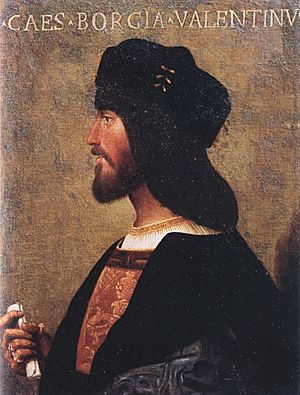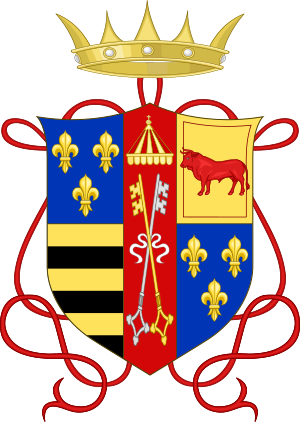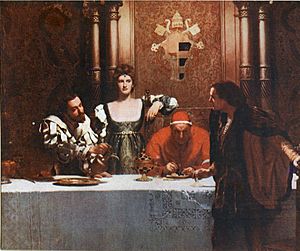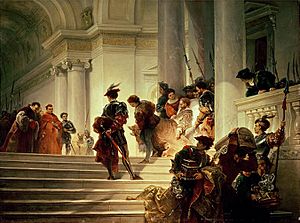Cesare Borgia facts for kids
Quick facts for kids
Cesare Borgia
|
|
|---|---|

Profile portrait of Cesare Borgia in the Palazzo Venezia in Rome, c. 1500–10
|
|
| Born | 13 September 1475 Subiaco, Papal States (now Italy)
|
| Died | 12 March 1507 (aged 31) |
| Resting place | Iglesia de Santa María (Viana) |
| Title | Duke of Valentinois |
| Spouse(s) | Charlotte of Albret |
| Children |
|
| Parent(s) | |
| Family | Borgia |
Cesare Borgia (born 13 September 1475 – died 12 March 1507) was an important Italian figure from the Renaissance period. He was a military leader, also known as a condottiero (which means a mercenary leader). He was also a former cardinal in the Catholic Church.
Cesare Borgia was the son of Pope Alexander VI. His family, the House of Borgia, was very powerful. Cesare's efforts to gain and keep power were a big inspiration for The Prince, a famous book by Niccolò Machiavelli.
After starting his career in the Church and becoming a cardinal, he later left the Church to become a military commander. He fought for King Louis XII of France and gained control of parts of Central Italy. He tried to create his own state, but after his father's death, he lost his power.
Contents
Early Life and Family
Cesare Borgia was born in Subiaco, Italy. His exact birth year is debated, but it was either 1475 or 1476. He was the son of Cardinal Roderic Llançol i de Borja, who later became Pope Alexander VI. His mother was Vannozza dei Cattanei.
The Borgia family originally came from the Kingdom of Valencia in Spain. They became very important in the 15th century. Cesare's great-uncle, Alphonso Borgia, became Pope Callixtus III in 1455. Cesare's father, Pope Alexander VI, was the first pope who openly recognized his children born outside of marriage.
Career in the Church
Cesare Borgia was first prepared for a career in the Church. He studied law at the University of Rome.
- At age 15, he became the Bishop of Pamplona.
- At age 17, he became the Archbishop of Valencia.
- When his father became Pope, Cesare was made a Cardinal at age 18.
The Borgia family had hoped that Cesare's brother, Giovanni, would lead their military forces. However, Giovanni was killed in 1497. Some people at the time thought Cesare might have been involved, as Giovanni's death opened the way for Cesare to pursue a military career. His exact role in this event has never been fully clear.
On 17 August 1498, Cesare resigned from his position as cardinal. This allowed him to start a military career. On the same day, King Louis XII of France named Cesare the Duke of Valentinois. This title, along with his past role as Cardinal of Valencia, gave him the nickname "Valentino."
Military Campaigns
Cesare's military career grew because of his father's support and his alliance with France. This alliance was made stronger when Cesare married Charlotte d'Albret, the sister of John III of Navarre. In 1499, King Louis XII invaded Italy, and Cesare joined him when he entered Milan.

Pope Alexander VI wanted to use this opportunity to create a state for Cesare in northern Italy. He declared that the local rulers in Romagna and Marche were no longer in power. These rulers had been cruel, so when Cesare took over, many citizens saw it as an improvement.
Cesare was made the commander of the papal armies. He had Italian mercenaries and soldiers from France and Switzerland. He captured Imola and Forlì. After these victories, he returned to Rome and was given the title of Papal Gonfalonier by his father. This meant he was the chief military commander for the Pope.
In 1500, Cesare hired more condottieri (mercenary leaders) like Vitellozzo Vitelli and the Orsini brothers. He continued his campaigns in Romagna:
- He removed Giovanni Sforza from Pesaro.
- Pandolfo Malatesta lost Rimini.
- Faenza surrendered, and its young ruler was later killed by Cesare's order.
In May 1501, Cesare was made Duke of Romagna. He also gained control of Piombino. His troops also helped the French in sieges of Naples and Capua, which weakened Spanish power in southern Italy.
In June 1502, Cesare captured Urbino and Camerino through clever tactics. He then planned to conquer Bologna. However, his mercenary leaders, especially Vitellozzo Vitelli and the Orsini brothers, became worried about Cesare's power and cruelty. They plotted against him. Cesare, known for his cunning, pretended to reconcile with them. He then trapped them in Senigallia and had them killed. This event was seen as a "wonderful deceiving" by historians. In 1503, he conquered the Republic of San Marino.
Later Years and Death
Cesare Borgia was a very skilled general and leader. However, his power depended heavily on his father, the Pope. Niccolò Machiavelli pointed out that this dependence was Cesare's main weakness. When his father died in 1503, Cesare was planning to conquer Tuscany. He was also sick with a fever at the time.
The new pope, Pope Pius III, supported Cesare at first, but he died after only 26 days. Then, Cesare's enemy, Giuliano Della Rovere, became Pope Julius II. Pope Julius II tricked Cesare into supporting him and then went back on his promises. Cesare lost his lands, which were taken back by the Papacy. He was also forced to give up San Marino.
Cesare Borgia was then betrayed and imprisoned in Naples. In 1504, he was sent to Spain and held in different castles. He managed to escape from the Castle of La Mota in 1506. He then went to Pamplona in Navarre, where he was welcomed by King John III of Navarre. The King needed an experienced military commander because of a feared Spanish invasion.
Borgia helped the King of Navarre by recapturing Viana. However, he was killed during a battle on 11 March 1507. He was chasing enemy knights during a storm and found himself alone. The knights realized he was by himself and ambushed him, causing a fatal injury.
Burial and Remains
Cesare Borgia was first buried in a special tomb in the Church of Santa María in Viana, Navarre. An epitaph (a short text on a tombstone) was written for him. It spoke of him as someone everyone feared, who held peace and war in his hand.
However, Cesare was an old enemy of Ferdinand of Aragon. His tomb was destroyed sometime between 1523 and 1608, possibly because a local Bishop thought it was wrong to have his remains in the church. His bones were then reburied under the street in front of the church.
For many years, people thought his bones were lost. But local traditions kept the location known. Historians later dug up his bones twice, in 1886 and 1945, to confirm they were indeed Cesare Borgia's.
In 1953, his remains were reburied just outside the Church of Santa María, no longer under the street. A memorial stone was placed there, calling him the Generalissimo (chief commander) of the papal and Navarrese forces. There have been efforts to move his bones back inside the church, but church officials have rejected these requests.
Evaluation by Machiavelli

Niccolò Machiavelli, a famous writer and diplomat, met Cesare Borgia between 1502 and 1503. Machiavelli wrote about Cesare in his famous book, The Prince.
Machiavelli used Cesare Borgia as an example to show the difficulties of gaining power through someone else. Even though Cesare's father gave him power, Cesare ruled the Romagna region skillfully. But when his father died, and a rival became Pope, Cesare lost his power quickly.
Machiavelli admired Cesare's methods for bringing peace to the Romagna region and his cleverness in dealing with his enemies, like when he had his captains killed in Senigallia. Some scholars debate Machiavelli's view of Borgia, but many agree that Machiavelli saw him as a powerful and effective, though sometimes ruthless, leader.
Borgia and Leonardo da Vinci
Cesare Borgia briefly hired Leonardo da Vinci, the famous artist and inventor, as a military architect and engineer between 1502 and 1503. Cesare gave Leonardo special permission to inspect and direct all building projects in his lands. While working for Cesare, Leonardo built a canal from Cesena to Porto Cesenatico.
Before working for Cesare, Leonardo had worked for the Duke of Milan. After Cesare, Leonardo found it hard to find another patron in Italy. Eventually, King Francis I of France convinced Leonardo to work for him, and Leonardo spent his last years in France.
Personal Life
On 10 May 1499, Cesare married Charlotte of Albret (1480 – 11 March 1514). She was the sister of King John III of Navarre. This marriage helped improve relations between the King of France and the Pope. Cesare and Charlotte had one daughter, Louise Borgia (1500–1553).
Cesare also had at least 11 other children born outside of marriage.
Machiavelli, who spent time with Cesare, described him as a complex person. He could be secretive and quiet at times, but also talkative and boastful. He would sometimes work tirelessly all night, sending messages, and other times he would stay in bed and refuse to see anyone. He was easily offended but also open with his people, enjoying local sports. Machiavelli also noted Cesare's incredible energy and genius in military and diplomatic matters, often working for days without sleep.
Cesare was known for his high intelligence, which was recognized early in his life. His skill as a military commander and battle planner was respected by both his friends and enemies. Many people who knew him mentioned his intelligence. He was able to gain the strong loyalty of his troops and his close friend, Micheletto Corella.
Non-fiction Literature
- The Life of Cesare Borgia (1912) by Rafael Sabatini
- Cesare Borgia: The Machiavellian Prince (1942) by Carlo Beuf
- A Triptych of Poisoners (1958) by Jean Plaidy
- Cesare Borgia (1976) by Sarah Bradford
- The Borgias (1981) by Sarah Bradford and John Prebble
- The Artist, The Philosopher and the Warrior (2009) by Paul Strathern
- The Borgias: The Hidden History (2013) by G. J. Meyer
- Cesare Borgia in a Nutshell (2016) by Samantha Morris
Fictional Portrayals
- Cesare is a character in Prince of Foxes, a 1947 historical fiction novel by Samuel Shellabarger. In the 1949 film adaptation, he is played by Orson Welles.
- In the 1981 BBC TV series The Borgias, Cesare is played by Oliver Cotton.
- Cesare appears as the main bad guy in the 2010 video game Assassin's Creed: Brotherhood. He is voiced by Andreas Apergis.
- In The Borgias, a 2011 American TV series, Cesare is played by Francois Arnaud.
- In Borgia, a 2011 European TV series, Cesare is played by Mark Ryder.
- The Hatsune Miku & KAITO song "Cantarella" is based on Cesare Borgia and his sister Lucrezia Borgia.
- The Cantarella manga by You Higuri is a fantasy historical story about Cesare's life with some supernatural parts.
- Cesare: Hakai no Sōzō-sha is a manga by Fuyumi Soryo that tells his life story from age 15.
See also
 In Spanish: César Borgia para niños
In Spanish: César Borgia para niños
- Rocca di Borgia
- Route of the Borgias
Images for kids



